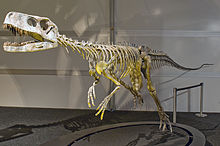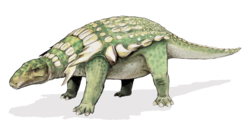
Portal:Dinosaurs

IntroductionDinosaurs are a diverse group of reptiles of the clade Dinosauria. They first appeared during the Triassic period, between 243 and 233.23 million years ago (mya), although the exact origin and timing of the evolution of dinosaurs is a subject of active research. They became the dominant terrestrial vertebrates after the Triassic–Jurassic extinction event 201.3 mya and their dominance continued throughout the Jurassic and Cretaceous periods. The fossil record shows that birds are feathered dinosaurs, having evolved from earlier theropods during the Late Jurassic epoch, and are the only dinosaur lineage known to have survived the Cretaceous–Paleogene extinction event approximately 66 mya. Dinosaurs can therefore be divided into avian dinosaurs—birds—and the extinct non-avian dinosaurs, which are all dinosaurs other than birds.  Dinosaurs are varied from taxonomic, morphological and ecological standpoints. Birds, at over 11,000 living species, are among the most diverse groups of vertebrates. Using fossil evidence, paleontologists have identified over 900 distinct genera and more than 1,000 different species of non-avian dinosaurs. Dinosaurs are represented on every continent by both extant species (birds) and fossil remains. Through the first half of the 20th century, before birds were recognized as dinosaurs, most of the scientific community believed dinosaurs to have been sluggish and cold-blooded. Most research conducted since the 1970s, however, has indicated that dinosaurs were active animals with elevated metabolisms and numerous adaptations for social interaction. Some were herbivorous, others carnivorous. Evidence suggests that all dinosaurs were egg-laying, and that nest-building was a trait shared by many dinosaurs, both avian and non-avian. (Full article...) 
Selected article
Herrerasaurus (meaning 'Herrera's lizard', after the name of the rancher who discovered the first fossil of the animal) was one of the earliest dinosaurs. All known specimens of this carnivore have been discovered in rocks of late Ladinian age (middle Triassic according to the ICS, dated to 231.4 million years ago) in northwestern Argentina. The type species, Herrerasaurus ischigualastensis, was described by Osvaldo Reig in 1963 and is the only species assigned to the genus. The names Ischisaurus and Frenguellisaurus are synonymous with Herrerasaurus.
For many years, the classification of Herrerasaurus was unclear, as the animal was initially known from very fragmentary remains; it has been hypothesized to be a basal theropod, a basal sauropodomorph, a basal saurischian, or not a dinosaur at all. However, with the discovery of a mostly complete skeleton and skull in 1988, Herrerasaurus has been classified as either an early theropod or an early saurischian in at least five recent reviews of theropod evolution. It was a member of the Herrerasauridae, a group of similar animals which were among the earliest of the dinosaurian evolutionary radiation. (see more...) 
TopicsSubcategoriesSelected imageDid you know...
Things you can do
Articles to be split 

Related content
Associated WikimediaThe following Wikimedia Foundation sister projects provide more on this subject: 
Discover Wik.ipedia.Pro using portals |
See what we do next...
OR
By submitting your email or phone number, you're giving mschf permission to send you email and/or recurring marketing texts. Data rates may apply. Text stop to cancel, help for help.
Success: You're subscribed now !

































